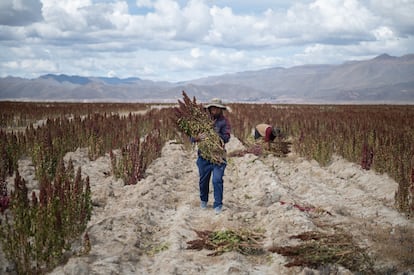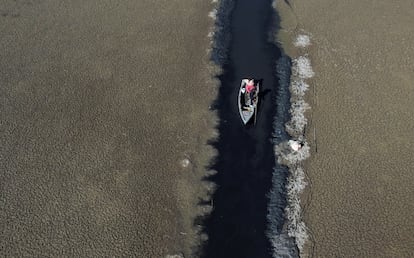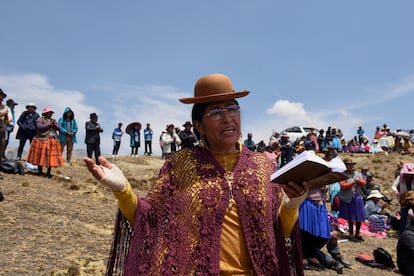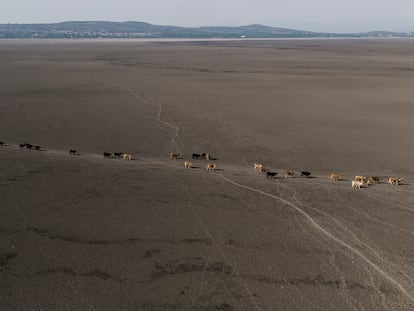Severe drought parches Bolivia: ‘My biggest fear is running out of food and water’
The country’s agricultural production is dropping and over half the population faces food insecurity, warns Save the Children

Seven of the nine departments in Bolivia are currently experiencing severe drought and a lack of rainfall. This has jeopardized the water and food supply for over 200,000 families, particularly in the Andean region. The water crisis, worsened by climate change, has damaged crops and killed livestock. To tackle this emergency, the government is implementing broad measures and investments, anticipating an even drier 2024 due to the El Niño phenomenon.
“This drought… my biggest fear is running out of food and water,” said María Eugenia Chuquimia, who lives with her husband and five children in Lorocota, a community of 250 people about nine miles (15 kilometers) north of La Paz. Her family lives on what their small farm produces. Due to the lack of rainfall, Bolivian authorities have imposed water rationing. The Chuquimia family cannot water their crops anymore, and their home only receives unpurified spring water for two hours each day.
“We can’t just open the tap and get water like in the city. We have to ration it. And we have to wash our clothes in the river, which is polluted from the mines. It’s really tough for us to get clean water,” said Nora Condori, another resident of Lorocota. Both women plant lettuce, potatoes, and oca (an Andean tuber similar to a yam) that they take to sell in La Paz. Their products are organic — they avoid chemical pesticides and instead rely on natural methods of pest control. “If it doesn’t rain, we can’t plant and the potatoes won’t grow. And if we don’t water the fields, the pests become more of a problem. Then the soil dries out and doesn’t produce anything. If we keep going like this, Bolivia may be facing a famine,” said Chuquimia.

Bolivia’s Andean departments have been significantly affected by a lack of rain since at least 2016. Oruro has been declared a disaster area, while La Paz, Cochabamba, and Chuquisaca are in emergency status. Potosí and Tarija have also been severely affected. In Santa Cruz, the country’s largest department with over four million inhabitants, some municipalities have already begun rationing. This region is Bolivia’s economic engine and produces 61% of the country’s food, most of which is exported.
According to a recent report from the country’s National Institute of Statistics, the amount of rainfall in Bolivia has decreased by 28% in the last five years. Annual rainfall was 606 cubic inches (9,941 millimeters) in 2018, dropping to 439 cubic inches (7,192 millimeters) in 2022. The report also states that between January and August of this year, only 298 cubic inches (4,882 millimeters) of precipitation have fallen.
In La Paz, the capital of Bolivia, where over two million people live at an altitude of over 11,800 feet (3,600 meters), government authorities have chosen not to implement water rationing. Despite the city’s reservoirs being 50% below capacity, they have instead chosen to encourage changes in habits such as using less water for laundry and bathing, and irrigating public parks with gray water.
Potosí, a city of around 850,000 people, is facing a severe water shortage and a department-wide emergency has been declared. The city is currently rationing water as the 27 reservoirs and lakes that supply the city will run dry in December. Distribution of potable water has been cut in half, and the irrigation of parks and gardens is prohibited.
According to the Vice Ministry of Civil Defense, the drought in Bolivia has affected 200,871 families in 144 of the country’s 336 municipalities. The government has allocated $17 million to tackle the current drought, and is implementing over 800 water, sanitation, and irrigation projects. An emergency program now provides large-volume water tanks (300-1,300 gallons) to many affected municipalities.
Agricultural production and food insecurity
According to Save the Children, more than half of Bolivia’s population currently faces food insecurity, especially in rural areas. “As extreme weather events continue to intensify, agriculture and livestock in the country are being decimated, exacerbating the situation.” In 2022, Bolivia produced 4.5 million tons of its main food crops — soybeans, sorghum, corn, wheat, and sunflowers. This is 5% lower than the 2021 total of 4.7 million tons, says the Bolivian Association of Oilseed and Wheat Producers (ANAPO).
“The impacts of climate change — drought, cold fronts and lack of irrigation water — make it harder for Bolivians to produce food,” said Carla Cordero, a social policy analyst with the Jubilee Foundation. Cordero says that 60% of the agricultural production in drought-affected Andean regions is consumed locally. The decrease in production impacts the market, driving up prices for increasingly scarce, low-quality food, ultimately affecting food security. “This leads to families in extreme poverty being unable to get enough good-quality food to maintain proper nutrition,” she said. According to the Ministry of Rural Development and Lands, the drought has affected 62,130 acres (25,143 hectares) of croplands and 163,000 heads of livestock this year.
‘We need rain!’
Farmers and religious congregations make pilgrimages to seek rain in the hills and reservoirs around La Paz. They pray to Pachamama (Mother Earth in Aymara) and the God of the Bible, asking for rainfall. “Father, we need rain, we need water!” they shouted as they prayed on the shores of the Incachaca reservoir.

Meteorologists are forecasting that the El Niño phenomenon in early 2024 will exacerbate the region’s climate changes, causing below-normal rainfall in the Andean areas, ongoing drought conditions and high summer temperatures. Bolivia has experienced abnormally high temperatures in recent months. According to the National Meteorology and Hydrology Service (SENAMHI), temperatures in high-altitude La Paz reached 81.5 °F (27.5 °C) in September, the highest it has been since 2010. Villamontes, a town in southern Bolivia, reached 113 °F (45 °C) in August, setting a record for the highest winter temperature in the Southern Hemisphere.
“Regrettably, humans are one of the most damaging species on Earth. Our high emissions of pollutants directly affect the climate and have a global impact,” said Michelle Vásquez, head of SENAMHI’s agriculture unit. Experts concur that addressing the water crisis requires the implementation of short, medium and long-term public policies, which should involve both the government and the community. Failure to take action will only exacerbate social vulnerability throughout Bolivia.
Sign up for our weekly newsletter to get more English-language news coverage from EL PAÍS USA Edition
Tu suscripción se está usando en otro dispositivo
¿Quieres añadir otro usuario a tu suscripción?
Si continúas leyendo en este dispositivo, no se podrá leer en el otro.
FlechaTu suscripción se está usando en otro dispositivo y solo puedes acceder a EL PAÍS desde un dispositivo a la vez.
Si quieres compartir tu cuenta, cambia tu suscripción a la modalidad Premium, así podrás añadir otro usuario. Cada uno accederá con su propia cuenta de email, lo que os permitirá personalizar vuestra experiencia en EL PAÍS.
¿Tienes una suscripción de empresa? Accede aquí para contratar más cuentas.
En el caso de no saber quién está usando tu cuenta, te recomendamos cambiar tu contraseña aquí.
Si decides continuar compartiendo tu cuenta, este mensaje se mostrará en tu dispositivo y en el de la otra persona que está usando tu cuenta de forma indefinida, afectando a tu experiencia de lectura. Puedes consultar aquí los términos y condiciones de la suscripción digital.
More information
Archived In
Últimas noticias
Most viewed
- David King, chemist: ‘There are scientists studying how to cool the planet; nobody should stop these experiments from happening’
- Reinhard Genzel, Nobel laureate in physics: ‘One-minute videos will never give you the truth’
- Mexico completes its trade shift with the entry into force of tariffs on China and countries without trade agreements
- Oona Chaplin: ‘I told James Cameron that I was living in a treehouse and starting a permaculture project with a friend’
- Sinaloa Cartel war is taking its toll on Los Chapitos










































